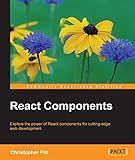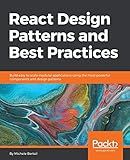Best React Mapping Tools to Buy in December 2025

Professional React Native: Expert techniques and solutions for building high-quality, cross-platform, production-ready apps



React Key Concepts: An in-depth guide to React's core features



React Components



Fluent React: Build Fast, Performant, and Intuitive Web Applications



Learning React: Modern Patterns for Developing React Apps



React Design Patterns and Best Practices: Build easy to scale modular applications using the most powerful components and design patterns


To map over an array and render components in React, you can use the map method provided by JavaScript arrays. This method allows you to iterate over each item in the array and return a new array with the transformed values.
In React, you can map over an array of data and render components by using the map method inside the render method of your component. Within the map function, you can return the JSX for each component that you want to render based on the data in the array.
For example, if you have an array of items called data and you want to render a component for each item in the array, you can do so by using the map method like this:
render() { const data = [item1, item2, item3]; // array of items return ( {data.map(item => ( ))} ); }
In this example, Component is the component you want to render for each item in the data array. By using the map method, you can dynamically render components based on the data in the array. Just make sure to provide a unique key prop for each component to help React efficiently update the component tree.
What is the purpose of mapping over an array in React?
Mapping over an array in React allows for rendering of multiple elements based on the data inside the array. It helps in creating dynamic and flexible components that can adapt to various amounts of data by displaying a new element for each item in the array. This makes it easier to manage and display lists or collections of data in a more efficient way without needing to manually write out each individual element.
How to render components in React using the map function?
To render components in React using the map function, you can follow these steps:
- Create an array of data that you want to render in your component. This could be an array of objects, strings, numbers, etc.
- In your functional component, use the map function on the data array to iterate over each item and return a new array of React components.
- Within the map function, you can return JSX elements that represent the components you want to render. You can also pass any necessary props to these components.
- Finally, display the array of components within your component's return statement.
Here is an example of how you can render a list of items using the map function in React:
import React from 'react';
const items = ['Item 1', 'Item 2', 'Item 3'];
const ListComponent = () => { return ( List of items: {items.map((item, index) => ( {item} ))} ); }
export default ListComponent;
In this example, we have an array of strings items that we want to render as list items within a <ul> element. We use the map function to iterate over each item in the items array, and return a <li> element for each item. We also provide a key prop to each <li> element to help React identify each list item uniquely.
This will result in a list component that displays each item from the items array as a list item on the rendered page.
How to conditionally render components while mapping over an array in React?
You can conditionally render components while mapping over an array in React by using JavaScript's ternary operator within the map function.
Here is an example of how to conditionally render components while mapping over an array in React:
import React from 'react';
const Component = () => { const data = [ { id: 1, type: 'A' }, { id: 2, type: 'B' }, { id: 3, type: 'A' }, { id: 4, type: 'B' } ];
return ( {data.map(item => ( item.type === 'A' ? Type A Component : Type B Component ))} ); }
export default Component;
In this example, we are mapping over the data array and rendering different components based on the type property of each item in the array. If the type is 'A', we render a div element with the text "Type A Component", otherwise, we render a span element with the text "Type B Component".
By using the ternary operator within the map function, you can conditionally render components while mapping over an array in React.
How to handle errors when mapping over an array in React?
When mapping over an array in React, it is important to handle errors that may occur during the mapping process. Here are some ways to handle errors when mapping over an array in React:
- Use conditional rendering: Check if the array is not null or undefined before mapping over it. If the array is empty or null, you can render a message or component to indicate that there are no items to display.
{array && array.map(item => ( ))}
- Use try-catch block: Wrap your mapping logic in a try-catch block to catch any errors that may occur during the mapping process. You can then handle the error and display an appropriate message to the user.
try { return array.map(item => ( )); } catch (error) { console.error(error); return ; }
- Handle errors within the mapping function: You can also handle errors within the mapping function itself by using conditional logic or try-catch blocks to handle errors specific to each item in the array.
{array.map(item => { try { return ; } catch (error) { console.error(error); return ; } })}
By implementing these strategies, you can effectively handle errors that may occur when mapping over an array in React and provide a seamless user experience.
